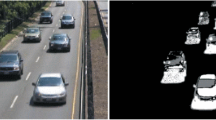Abstract
This paper describes a vision-based car distance measuring system capable of telling the driver the gap distance between the host vehicle and the vehicle in front. The aim is to increase the road safety by warning the driver if the driving distance is too close and therefore can cause dangerous situation, and hence provide comfort driving condition for car users. The system uses the size of number plate characters to determine the distance. With the help of an image pre-processing stage, the region of interest (ROI) in the acquired images is identified. The ROI is then examined by a rule-based algorithm that identifies the characters in the plate and computes the corresponding height of the plate characters and thus the distance between the cars. Finally, in order to reduce the complexity of the algorithm, we propose a number plate tracking technique that continuously tracks and computes the height of the characters. We show the system working in real situations and results are discussed.
Access this chapter
Tax calculation will be finalised at checkout
Purchases are for personal use only
Preview
Unable to display preview. Download preview PDF.
Similar content being viewed by others
References
ReportLinker: Driver assistance systems market overview, technical review and forecasts to 2013. technical reports (March 2007)
Malec, J., Morin, M., Palmavist, U.: Driver support in intelligent autonomous cruise control. In: Proceedings of the IEEE Intelligent Vehicles Symposium, pp. 160–164 (1994)
Gorjestani, A., Donath, M., Alexander, L.: Radar based longitudinal virtual bumper collision avoidance system implemented on a truck. Technical reports (1999)
Stein, G., Mano, O., Shashua, A.: Vision-based acc with a single camera: bounds on range and range rate accuracy. In: IEEE Intelligent Vehicles Symposium (IV 2003), pp. 120–125 (June 2003)
Hou, P., Zhao, J., Lui, M.: A license plate locating method based on tophat-bothat changing and line scanning. Journal of Physics: Conference Series (2006)
Draghici, S.: A neural network based artificial vision based system for license plate recognition. In: IJNS, February 1997, pp. 113–126 (1997)
Rezaie, F.F.A., Ziaratban, M.: A morphological-based license plate location. In: Conference, I.I., ed.: Journal. Vol. 1, 57–60 (October 2007)
Reginaldo, L., Curado, A.F., Bauchspiess, A., Curado, V.B.: Using pca to recognize characters in vehicle license plates. In: IPCV 2006, pp. 264–268 (2006)
Enyedi, B., Konyha, L., Fazekas, K.: Real time number plate localization algorithms. Journal of Electrical Engineering 57(2), 69–77 (2006)
Suresh, K., Kumar, G.M., Rajagopalan, A.N.: Superresolution of license plates in real traffic videos. IEEE Transactions on Intelligent Transportation 8(2) (June 2007)
Parker, J., Federl, P.: An approach to licence plate recognition. Technical reports (1996)
Zhu, W.: Number plate recognition system. Tatung University Technical report (2007)
Lienhart, R., Effelsberg, W.: Automatic text segmentation and text recognition for video indexing. Technocal reports 8(1), 69–81 (1998)
Nishi, T., Yamazaki, N., Koite, S., Kuno, T., Umezaki, T.: Collision avoidance system using laser beam. Image and Vision Computing (2005)
Mirmehdi, M., Clark, P., Lam, J.: Extracting low resolution text with an active camera for ocr. In: Proc. IX Spanish Sym. Pat. Rec. Image Proc., pp. 43–48 (2001)
BBCnews: Warning over dirty number plates (November 12, 2005)
Author information
Authors and Affiliations
Editor information
Editors and Affiliations
Rights and permissions
Copyright information
© 2010 Springer-Verlag Berlin Heidelberg
About this paper
Cite this paper
Chan, K., Ordys, A., Duran, O. (2010). A System to Measure Gap Distance between Two Vehicles Using License Plate Character Height. In: Bolc, L., Tadeusiewicz, R., Chmielewski, L.J., Wojciechowski, K. (eds) Computer Vision and Graphics. ICCVG 2010. Lecture Notes in Computer Science, vol 6374. Springer, Berlin, Heidelberg. https://doi.org/10.1007/978-3-642-15910-7_28
Download citation
DOI: https://doi.org/10.1007/978-3-642-15910-7_28
Publisher Name: Springer, Berlin, Heidelberg
Print ISBN: 978-3-642-15909-1
Online ISBN: 978-3-642-15910-7
eBook Packages: Computer ScienceComputer Science (R0)




